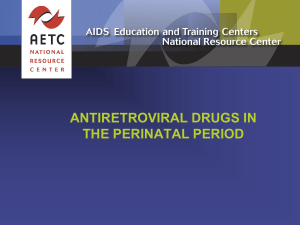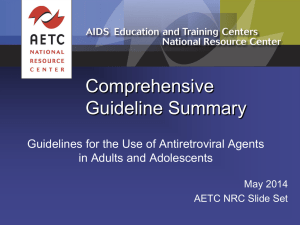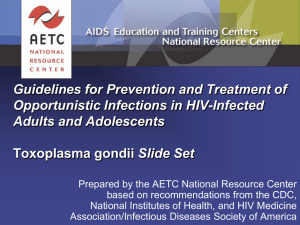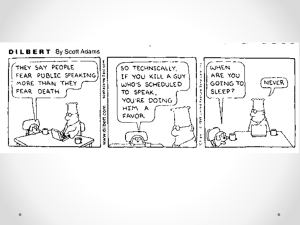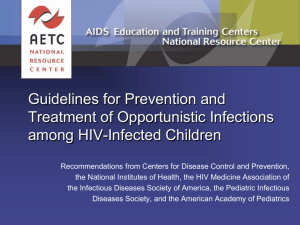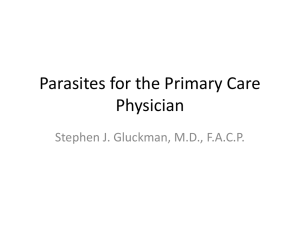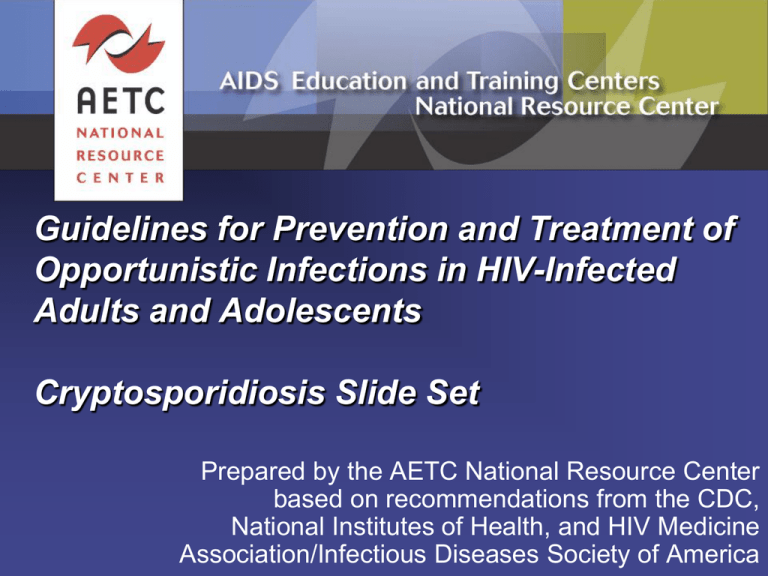
Guidelines for Prevention and Treatment of
Opportunistic Infections in HIV-Infected
Adults and Adolescents
Cryptosporidiosis Slide Set
Prepared by the AETC National Resource Center
based on recommendations from the CDC,
National Institutes of Health, and HIV Medicine
Association/Infectious Diseases Society of America
About This Presentation
These slides were developed using recommendations
published in May 2013. The intended audience is
clinicians involved in the care of patients with HIV.
Users are cautioned that, because of the rapidly
changing field of HIV care, this information could
become out of date quickly. Finally, it is intended that
these slides be used as prepared, without changes in
either content or attribution. Users are asked to honor
this intent.
-AETC National Resource Center
http://www.aidsetc.org
2
May 2013
www.aidsetc.org
Cryptosporidiosis: Epidemiology
Caused by Cryptosporidium species
Protozoan parasites
Infect small intestine mucosa; in
immunosuppressed patients, also infect
large intestine and other sites
Advanced immunosuppression (eg, CD4
<100 cells/µL) associated with prolonged,
severe, or extraintestinal disease
3
May 2013
www.aidsetc.org
Cryptosporidiosis: Epidemiology (2)
Infection results from ingestion of oocysts
excreted in feces of infected humans or
animals
Water supplies and recreational water
sources (oocysts may withstand standard
chlorination)
Person-to-person transmission common, via
oral-anal contact, from infected children to
adults (eg, during diapering), or care of
patients with diarrhea
4
May 2013
www.aidsetc.org
Cryptosporidiosis: Epidemiology (3)
Common cause of chronic diarrhea in AIDS
patients in developing countries
In developed countries with low rates of
envrionmental contamination and
widespread use of effective ART, <1 case
per 1,000 person-years in AIDS patients
5
May 2013
www.aidsetc.org
Cryptosporidiosis: Clinical Manifestations
Acute or subacute onset of profuse watery,
nonbloody diarrhea, often with nausea, vomiting,
and abdominal cramping
Fever in 1/3 of patients
Can be very severe, especially with immune
suppression
Malabsorption is common; dehydration,
electrolyte abnormalities, malnutrition may result
Biliary tract and pancreatic duct may be infected,
causing scleroding cholangitis and pancreatitis
Pulmonary infection is possible
6
May 2013
www.aidsetc.org
Cryptosporidiosis: Diagnosis
Microscopic identification of oocysts in
stool or tissue
DFA very sensitive, specific, is current gold
standard for stool specimens
Acid-fast staining often used
PCR extremely sensitive
ELISA or immunochromatographic tests
Small intestine biopsy with identification of
Cryptosporidium organisms
7
May 2013
www.aidsetc.org
Cryptosporidiosis: Diagnosis (2)
Single specimen usually sufficient in
profuse diarrhea
Repeat stool sampling is recommended in
mild disease
8
May 2013
www.aidsetc.org
Cryptosporidiosis: Prevention
Preventing exposure
Avoid exposure to infected contacts
Contact with diarrhea
Potential oral exposure to feces during sex
Direct contact with farm animals, stool from
pets
Scrupulous handwashing after potential
contact with feces (eg, after diapering), after
handling pets or other animals, gardening,
before preparing food or eating, before and
after sex
9
May 2013
www.aidsetc.org
Cryptosporidiosis: Prevention (2)
Avoid exposure to contaminated water,
food
Do not drink or swallow water from
recreational sources (lakes, streams, pools)
Ice, fountain beverages, water fountains may
be contaminated
Avoid raw oysters
10
May 2013
www.aidsetc.org
Cryptosporidiosis: Prevention (3)
Boil tap water for ≥1 minute during
outbreaks or when community advisory is
issued
Submicron water filters or bottled water may
reduce risk
For non-outbreak settings, data are
inadequate to recommend that all persons
with low CD4 counts avoid drinking tap
water
Consider drinking only filtered water
11
May 2013
www.aidsetc.org
Cryptosporidiosis: Prevention (4)
Preventing disease
Primary prophylaxis:
Appropriate initiation of ART before severe
immunosuppression should prevent disease
Rifabutin and possibly clarithromycin are
protective, but data insufficient to recommend
as chemoprophylaxis
12
May 2013
www.aidsetc.org
Cryptosporidiosis: Treatment
Preferred strategies
ART with immune restoration (to CD4 count
>100 cells/µL)
Usually results in complete resolution; should be
offered as part of initial management of
cryptosporidiosis
Symptomatic treatment: antidiarrheals
Tincture of opium may be more effective than
loperamide
Octreotide usually not recommended (no more
effective than other antidiarrheals)
Supportive care: aggressive hydration,
electrolyte repletion, nutritional support (IV
therapies may be needed)
13
May 2013
www.aidsetc.org
Cryptosporidiosis: Treatment (2)
Alternative strategies
No consistently effective antimicrobial therapy
in absence of ART
Consider nitazoxanide or other antiparasitic
drugs in conjunction with ART, not instead of
ART
Nitazoxanide 500-1,000 mg PO BID for 14 days +
ART and other measures above
Some studies show clinical improvement with nitazoxanide
Paromomycin 500 mg PO QID for 14-21 days + ART
and other measures above
Limited data; may improve clinical response in conjunction
with ART
14
May 2013
www.aidsetc.org
Cryptosporidiosis: Starting ART
ART should be offered as part of initial
management of this infection
PIs inhibit Cryptosporidium in animal models –
some experts prefer PI-based ART
15
May 2013
www.aidsetc.org
Cryptosporidiosis: Monitoring and
Adverse Events
Monitor closely for volume depletion, electrolyte
loss, weight loss, and malnutrition
TPN may be indicated
IRIS not reported
16
May 2013
www.aidsetc.org
Cryptosporidiosis: Treatment Failure
Supportive treatment
Optimization of ART
17
May 2013
www.aidsetc.org
Cryptosporidiosis: Prevention of Recurrence
No effective prevention, other than
immune restoration with ART
18
May 2013
www.aidsetc.org
Cryptosporidiosis: Considerations in
Pregnancy
Rehydration and ART initiation as with
nonpregnant adults
Nitazoxanide not teratogenic in animals, but no
data in pregnant humans
Use after 1st trimester in severely symptomatic women
Paromomycin: limited information on
teratogenicity; minimal systemic absorption with
PO administration
Use after 1st trimester in severely symptomatic
women
19
May 2013
www.aidsetc.org
Cryptosporidiosis: Considerations in
Pregnancy (2)
Loperamide: possible risk of hypospadias with
1st-trimester exposure
Avoid during 1st trimester, unless benefits expected to
outweigh risks
Preferred antimotility agent during late pregnancy
Tincture of opium not recommended during late
pregnancy
Opiate exposure during late pregnancy associated with
neonatal respiratory depression; chronic exposure may
result in neonatal withdrawal
20
May 2013
www.aidsetc.org
Websites to Access the Guidelines
http://www.aidsetc.org
http://aidsinfo.nih.gov
21
May 2013
www.aidsetc.org
About This Slide Set
This presentation was prepared by
Susa Coffey, MD, and Oliver Bacon,
MD, for the AETC National Resource
Center in May 2013
See the AETC NRC website for the
most current version of this
presentation:
http://www.aidsetc.org
22
May 2013
www.aidsetc.org

